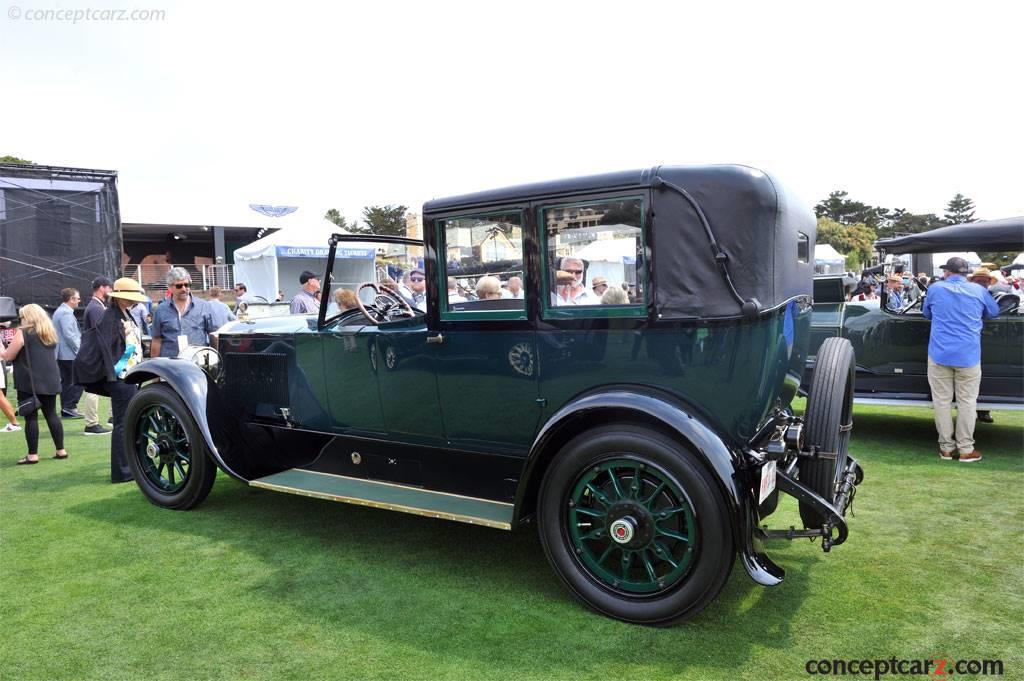The Packard Motor Car Company had firmly established its reputation by 1915 and was widely regarded as one of the world's finest makers of motorcars. Since its inception in 1899, originally founded in Warren, Ohio, the company produced well-constructed models and by 1905, they had moved to Detroit, Michigan. By that point in history, the company had moved away from one and two-cylinder mid-engine models and was offering more refined four-cylinder offerings. The pinnacle of Packard's four-cylinder model was the Model 30 introduced in 1907 which remained an integral part of the company's lineup until the introduction of a new six-cylinder model in 1912. The first Packard six would be known initially as just that -- the Six, later taking 'the 48' as its name.
Touring
View info and historyUnder the guidance of engineer Jesse Vincent and using their experience gained in building v-type aircraft and marine engines, the company began work on a twelve-cylinder automobile. By late 1915, production began on the model christened the 'Twin Six.' It was smooth, powerful, and flexible, and even famed sportsman Briggs Cunningham regarded the Twin Six as the fastest American car of its day. The chassis was essentially an evolution of the company's previous model, as the new and larger engine did not warrant a major redesign. The new V-12 was only marginally larger in displacement than the smaller of the two Sixes it would replace. The two blocks, each of six cylinders, were cast as a unit with the heads. Aluminum pistons, a product of WWI technology, reduced reciprocating mass. The crankshaft was smaller than the Six's and was supported in three main bearings. With an overall weight of 900 pounds, the new engine weighed 400 pounds less than the previous Six. The engine was backed by a three-speed transaxle and the suspension was comprised of a solid front and live rear axle with semi-elliptic leaf springs. Stopping power was provided by two-wheel mechanical brakes. Production of the new First Series Twin Six began in 1915 for the 1916 model year, available in two wheelbase lengths, with prices that ranged from $2,600 to $4,600 (less than its predecessor). The 135-inch chassis was referred to as the 1-35 and was offered with a choice of 13 bodies. Nine bodies were cataloged for the 125-inch 1-25. 
Touring
View info and historyThe L-head V12 engine installed in the 1919 Packard Twin Six displaced 424.1 cubic inches and used three main bearings, a Packard pressure-feed carburetor, and developed 90 horsepower at 2,600 RPM. The 128-inch wheelbase platform was known as the 3-25 and the larger 136-inch version was the 3-35. These larger wheelbase lengths were new for the Third Series Packards. Prices ranged from $3,450 to $5,150 for the 3-25 and $3,850 to $5500 for the larger version. Additional modifications and improvements bestowed upon the third series Twin Six included the relocation of the gearshift lever from the driver's left to the center of the floor, and the speedometer cable drive was now located on the transmission rather than the front wheel. Packard produced approximately 874 examples of the Model 3-25 in 1919 and 2,715 examples of the Model 3-35.
by Daniel Vaughan | Sep 2021

Touring
View info and history

Touring
View info and history
by Daniel Vaughan | Sep 2021
Related Reading : Packard Twin Six History
The Packard Twin Six was produced from 1915 - 1923. The name Twin Six would be revived years later eventually becoming known as the Packard Twelve. There were 7,746 examples of the Packard Twin Six sold in 1916, its introductory year, with figures increasing to 8,899 in 1917. This was an amazing accomplishment considering the relatively high starting price of %242,600 that these luxury cars demanded.....
Continue Reading >>
Continue Reading >>
Related Reading : Packard Twelve History
The Packard Twelve was produced from 1933 to 1939 with over 35,000 examples produced. It is considered by many to be one of the finest automobiles produced by Packard and one of the most significant creations of the classic car era. The long and flowing front hood hid a 445 cubic-inch side-valve twelve-cylinder engine that was refined, powerful, smooth, and quiet. The engine was originally destined....
Continue Reading >>
Continue Reading >>
Similar Automakers
Similarly Priced Vehicles
1919 Packard Twin Six Vehicle Profiles
Recent Vehicle Additions
Performance and Specification Comparison
Price Comparison
Twin Six Specification Comparison by Year
Year
Production
Wheelbase
Engine
Prices
Related Automotive News

Packards at The Greenbrier
The automobiles built by the Packard Motor Car Company were celebrated at this years Greenbrier Concours dElegance held in White...






















